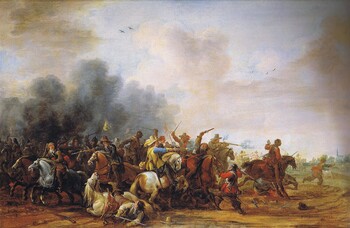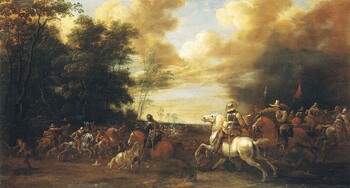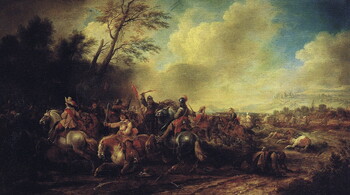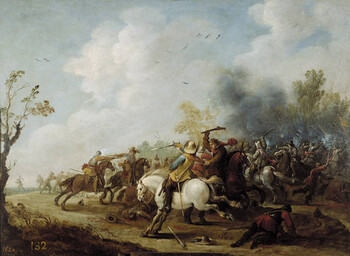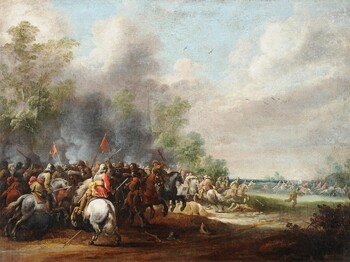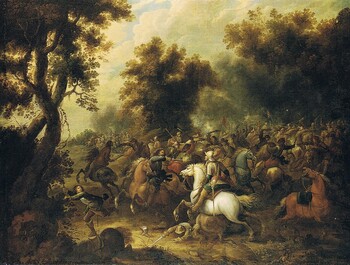6.400 €
A cavalry battle scene
Oil on panel : 42,5 X 66,6 cm
Signed bottom right “P.MEVLENERS.f”
The “f” stands for “fecit”, “made” in latin, next to it one might read “45”
(1645)
Frame : 57,1 X 81,2 cm
In short
Sebastiaen Vrancx, Pieter Snayers and Pieter Meulener were the best- known Flemish battle scene painters during the Eighty Year’s War.
In those days military uniforms did not yet exist; one recognized an ennemy by the colour of the sash he was wearing around his middle: red for the Spanish cavalrymen, orange and blue for the Dutch.
About Pieter Meulener
Sometimes called “Meuleneer”.
Flemish painter
Antwerp 1602 – 1654 Antwerp
Battle scene painter and occasionally painter of genre scenes in landscapes.
Pupil of his father, Jan Molenaer (who is not to be confused with the homonymous Dutch genre painter) and of Sebastiaen Vrancx (1573 -1647).
Master in the Painters’ Guild of Saint Luke in Antwerp in the year 1631/32.
His early works are influenced by Vrancx, although his colouring stands closer to Pieter Snayers (1592 – after 1666), also a former pupil of Vrancx
and Master since 1612/13.
After 1645 Meulener’s colouring became clearer, as he fell under the influence of Dutch battle scene painters, such as Pieter de Neyn, Jan Jacobsz. van der Stoffe and Abraham van der Hoeff, but especially of Palamedes Palamedesz., in so far that their works can be confused.
About our painting
Our painting represents a scene from the last years of the Eighty Year’s War. That war had started in 1568 as a Protestant uprising against the Catholic Spanish Habsburg. Rapidly it became a Dutch war of independence from Spain. It ended with the Peace of Westphalia in 1648: Spain recognized an independent Republic of the Seven United Provinces, Holland, while Flanders remained Spanish.
Specific military uniforms, identifying the camp to which a soldier belonged, only appeared at the end of the 17th century. During the 16th and almost the entire 17th century enemy cavalrymen recognized each other by the colours of sashes worn around the middle and by the colours of plumes attached to the hats and helmets. The Dutch wore orange (sometimes also blue as is the case here), the Spaniards red.
During the Eighty Year’s War foreign troops joined the Spanish or the Dutch side for religious or for political reasons, but finally also just for the money, as mercenaries:
- the Spaniards used Flemish, Walloon, German and even Croatian soldiers;
- the Dutch were helped by French, Irish, Scottish, English and Swedish troops.
Both Flemish and Dutch battle scene specialists favoured depictions with no references to time or place; specific battle scene paintings are very rare. Their clients who fought these cavalry battles belonged to the nobility and to the higher middle class. They made out a quarter of the army.
The battle tactics were rather rudimentary. One tried to approach the opponents as close as possible and then they would fire their one bullet pistol or riffle. The rest of the battle would be fought with a sword.
The use of iron armours and helmets was dual: it protected one from bullets, but at the same time it hindered every single movement. Therefore in the years following the Twelve Years’ Truce (1609 – 1621) we see less and less cavalrymen with armours and helmets. These got gradually replaced by heavy coats and hats. In our painting some of the cavalrymen wear an iron helmet or an iron breastplate, others chose velvet coats and hats.
Already in 1596 had Prince Maurice abolished the use of lances by cavalry.
Why should you buy this painting?
Because it is a typical, beautiful, fully signed historic document by one of the most famous Flemish battle scene specialists.
Comparative paintings
Click photos for more details


